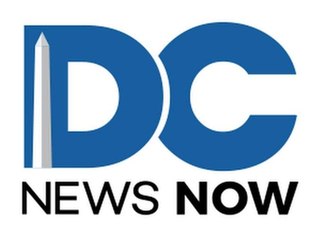Related Research Articles

KMSP-TV is a television station licensed to Minneapolis, Minnesota, United States, broadcasting the Fox network to the Twin Cities area. It is owned and operated by the network's Fox Television Stations division alongside MyNetworkTV outlet WFTC. Both stations share studios on Viking Drive in Eden Prairie; while KMSP-TV's transmitter is located in Shoreview, Minnesota.

WSTR-TV, branded on-air as Star 64, is a television station in Cincinnati, Ohio, United States, affiliated with MyNetworkTV. It is owned by Deerfield Media, which maintains joint sales and shared services agreements (JSA/SSA) with Sinclair Broadcast Group, owner of dual CBS/CW affiliate WKRC-TV, for the provision of advertising sales and other services. The two stations share studios on Highland Avenue in the Mount Auburn section of Cincinnati; WSTR's transmitter, Star Tower, is located in the city's College Hill neighborhood.

WUCW is a television station licensed to Minneapolis, Minnesota, United States, serving the Twin Cities area as an affiliate of The CW. Owned by Sinclair Broadcast Group, the station maintains studios in the Pence Building on 8th Street and Hennepin Avenue in downtown Minneapolis, and its transmitter is located at the Telefarm site in Shoreview.
WFTC is a television station licensed to Minneapolis, Minnesota, United States, broadcasting the MyNetworkTV programming service to the Twin Cities area. It is owned and operated by Fox Television Stations alongside Fox outlet KMSP-TV. Both stations share studios on Viking Drive in Eden Prairie, while WFTC's transmitter is located in Shoreview, Minnesota.

KVRR is a television station in Fargo, North Dakota, United States, affiliated with the Fox network. It is the flagship television property of locally based Red River Broadcasting, which has owned the station since its inception. KVRR's studios are located on South 40th Street and South 9th Avenue in Fargo, and its transmitter is located near Tansem, Minnesota. KVRR also handles master control and some internal operations for sister station and fellow Fox affiliate KQDS-TV in Duluth, Minnesota.

WDCW, branded on-air as DCW 50, is a television station in Washington, D.C., airing programming from The CW. It is owned and operated by network majority owner Nexstar Media Group alongside Hagerstown, Maryland–licensed independent station WDVM-TV. The two stations share studios on Wisconsin Avenue in the Glover Park section of Washington; however, master control and some internal operations are based at Springfield, Massachusetts–licensed Nexstar sister station and NBC affiliate WWLP's studios in Chicopee. Through a channel sharing agreement with Univision station WFDC-DT, WDCW transmits using WFDC's spectrum from a tower in the Tenleytown section of Washington's Northwest quadrant.
WEBC is an AM radio station located in Duluth, Minnesota, owned by Townsquare Media. It airs a sports format branded as "Northland Fan".

WGBO-DT is a television station licensed to Joliet, Illinois, United States, broadcasting the Spanish-language Univision network to the Chicago area. It is owned and operated by TelevisaUnivision alongside Aurora-licensed UniMás outlet WXFT-DT. Both stations share studios at 541 North Fairbanks Court in the Streeterville neighborhood, while WGBO's transmitter is located atop the John Hancock Center.
KPXG-TV is a television station licensed to Salem, Oregon, United States, broadcasting the Ion Television network to the Portland area. Owned and operated by the Ion Media subsidiary of the E. W. Scripps Company, the station has offices on Southwest Naito Parkway in downtown Portland, and its transmitter is located in the Sylvan-Highlands section of the city.
KZIO is a radio station located in Duluth, Minnesota that serves as a satellite station to Minnesota Public Radio's AAA station KCMP, with inserts for local weather, underwriting messages, and a local music program that airs on Sunday evenings. Established in 1995 as WRSR, the station is owned by American Public Media Group's Minnesota Public Radio. Its former owner was Red River Broadcasting, which also owns KQDS-TV channel 21 and formerly owned KQDS 1490, KQDS-FM 94.9, and WWAX 92.1 before deciding to sell their radio assets through 2015 into 2017. The studios under RRB ownership were located at Grandma's Marketplace in Canal Park in Duluth.

KSTS is a television station licensed to San Jose, California, United States, broadcasting the Spanish-language Telemundo network to the San Francisco Bay Area. It is owned and operated by NBCUniversal's Telemundo Station Group alongside NBC outlet KNTV ; it is also sister to regional sports networks NBC Sports Bay Area and NBC Sports California. KSTS and KNTV share studios on North 1st Street in the North San Jose Innovation District; KSTS's transmitter is located on Mount Allison, and two of its main subchannels are also broadcast from the KNTV tower on San Bruno Mountain.

KQDS-TV is a television station in Duluth, Minnesota, United States, affiliated with the Fox network. Owned by Red River Broadcasting, the station has studios on London Road in Duluth, and its transmitter is located west of downtown in Hilltop Park. Master control and some internal operations are based out of the studio facilities of sister station, fellow Fox affiliate and Red River flagship KVRR on South 40th Street and South 9th Avenue in Fargo, North Dakota.

ON TV was an American subscription television (STV) service that operated in eight markets between 1977 and 1985. Originally established by National Subscription Television, a joint venture of Oak Industries and Chartwell Communications, ON TV was part of a new breed of STV operations that broadcast premium programming—including movies, sporting events, and concerts—over an encrypted signal on a UHF television station and leased decoders to subscribing customers. At its peak in 1982, ON TV boasted more than 700,000 customers—more than half of them in Los Angeles, its most successful market. However, the rapidly expanding availability of cable television, coupled with a recession, caused the business to quickly lose subscribers at the same time that Oak Industries was experiencing severe financial difficulties. Between March 1983 and June 1985, all eight operations closed.

KCLO-TV is a television station in Rapid City, South Dakota, United States, affiliated with CBS and The CW Plus. Owned by Nexstar Media Group, the station maintains a news bureau and advertising sales office on Canyon Lake Drive in Rapid City, and its transmitter is located on Skyline Drive near downtown.
KUVM-CD, virtual channel 34, is a low-powered, Class A LATV-affiliated television station licensed to Houston, Texas, United States. The station is owned by HC2 Holdings. KUVM-CD's transmitter is located near Missouri City, in unincorporated northeastern Fort Bend County.
Fox 26 may refer to one of the following television stations in the United States affiliated with the Fox Broadcasting Company:

SelecTV was an American subscription television service that was formed in 1976 and first began broadcasting in 1978; the service focused entirely on televising movies, and was shut down in 1989.

Video Entertainment Unlimited (VEU) is a defunct American subscription television service that was owned by the Golden West Subscription Television, Inc. subsidiary of Golden West Broadcasters, which operated from May 1, 1980 until September 30, 1984. VEU aired a broad mix of feature films as well as sports events and specials.

WSNS-TV is a television station in Chicago, Illinois, United States, airing programming from the Spanish-language Telemundo network. It is owned and operated by NBCUniversal's Telemundo Station Group alongside NBC outlet WMAQ-TV ; it is also sister to regional sports network NBC Sports Chicago. WSNS-TV and WMAQ-TV share studios at the NBC Tower on North Columbus Drive in the city's Streeterville neighborhood and transmitter facilities atop the Willis Tower in the Chicago Loop.

KXJB-LD is a low-power television station licensed to Horace, North Dakota, United States, serving the Fargo–Grand Forks market as an affiliate of CBS and The CW Plus. It is owned Gray Television alongside NBC affiliate KVLY-TV. Both stations share studios on 21st Avenue South in Fargo, where KXJB-LD's transmitter is also located.
References
- ↑ "K26AC" (PDF). Television Factbook. 1997. p. B-59 (249). Retrieved June 27, 2020.
- ↑ Masland, Tom (January 4, 1982). "Low-Power TV To Speak in Local Accents". Hartford Courant. Knight-Ridder Newspapers. p. C2. Retrieved June 27, 2020.
- 1 2 3 "Low-power TV license granted for Bemidji". Minneapolis Tribune. Associated Press. May 15, 1981. p. 19B. Retrieved June 27, 2020.
- 1 2 Larson, Mark (January 9, 1982). "No time to quit: John Boler is just too busy to enjoy his days of retirement". Desert Sun. p. A4. Retrieved June 27, 2020.
- 1 2 Shaw, Sydney (March 27, 1982). "Is Low-Power TV In Your Future?". Brattleboro Reformer. UPI. p. 3. Retrieved June 27, 2020.
- 1 2 Lumenick, Lou (March 15, 1982). "Low-power TV: a new frontier". The Record. pp. A1, A12 . Retrieved June 27, 2020.
- 1 2 "John Boler, STV's voice of experience, talks about his year of operation" (PDF). Broadcasting. November 15, 1982. p. 88. Retrieved June 27, 2020.
- 1 2 "With a first, pioneer expands TV airwaves". St. Cloud Times. Associated Press. October 30, 1982. p. 11B. Retrieved June 27, 2020.
- 1 2 Alridge, Ron (April 18, 1982). "Low power TV: A high powered future?". Chicago Tribune. p. TV Week 4. Retrieved June 27, 2020.
- ↑ "Industry Statistics" (PDF). Broadcast Week. February 23, 1981. p. 16. Retrieved June 27, 2020.
- ↑ The News Tonight. K26AC. March 31, 1983. Retrieved June 27, 2020.
- ↑ Cooper, Ann (August 31, 1983). "TV going rural via full-power outlets". Baltimore Sun. pp. C1, C13 . Retrieved June 27, 2020.
- ↑ "End is near" (PDF). Broadcasting. February 3, 1986. p. 7.
- ↑ Richards, K.M. "Translators: The Complete Story". UHF Television. Retrieved June 27, 2020.
- ↑ "Construction Permits" (PDF). TV Factbook. 1988. p. A-1275 (79). Retrieved June 29, 2020.
- ↑ "KFTC/26 (Bemidji) will begin testing..." Northpine. September 22, 1999. Retrieved June 27, 2020.
- ↑ "Red River Broadcasting's FOX21 (KQDS-TV Duluth)..." Northpine. September 10, 1999. Retrieved June 27, 2020.
- ↑ "K29EB-D". fccdata.org. Retrieved June 27, 2020.